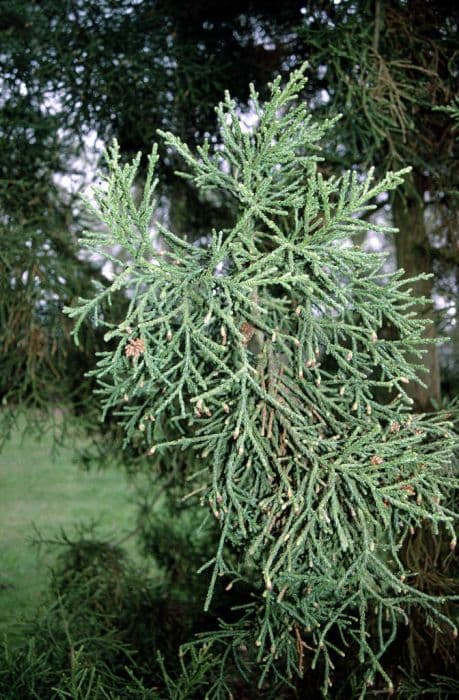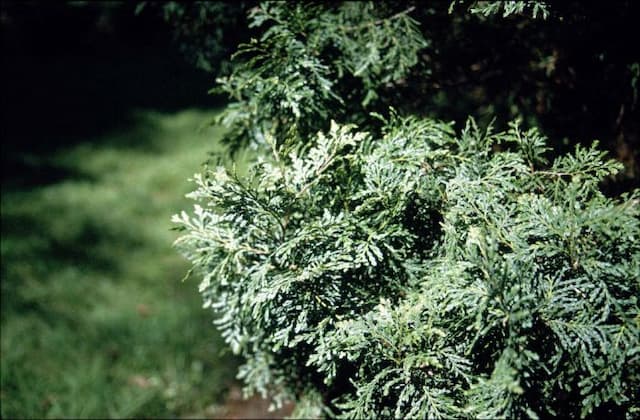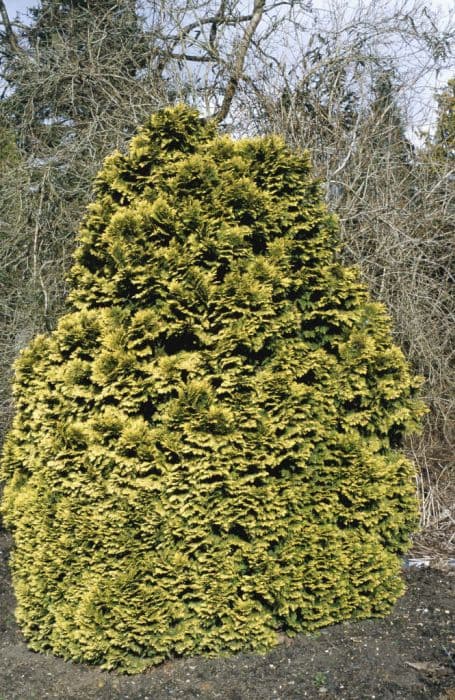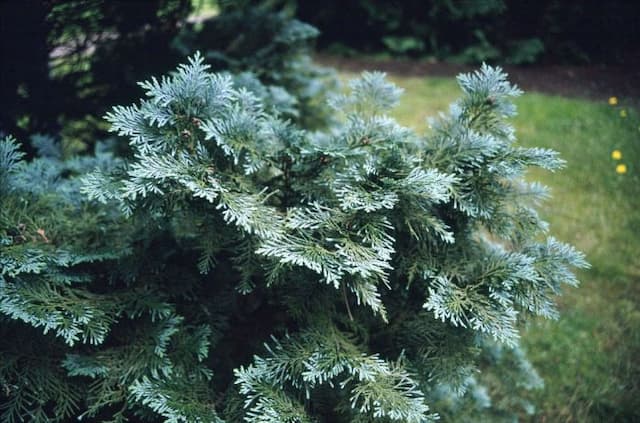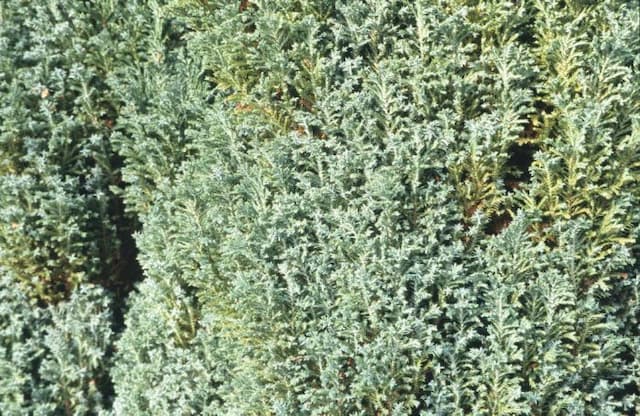Italian Cypress Cupressus sempervirens Stricta Group

ABOUT
The plant commonly known as the Italian cypress, specifically from the Stricta Group, is a type of evergreen tree that features a very narrow, columnar form. Its foliage consists of dense, dark green, scale-like leaves that are tightly packed together and provide a lush texture. Branches tend to grow upright, parallel to the central trunk, creating a slender silhouette that enhances its elegant appearance. Cones may appear that are small and round, typically not stand-out features against the dense foliage. The Italian cypress has a distinctive look that is often associated with Mediterranean landscapes, and its formal shape is commonly used to punctuate architectural features or line driveways and walkways, where its precise form can be most appreciated.
About this plant
 Names
NamesFamily
Cupressaceae
Synonyms
Italian Cypress, Mediterranean Cypress, Tuscan Cypress, Graveyard Cyprus, Pencil Pine
Common names
Cupressus sempervirens var. stricta, Cupressus stricta.
 Toxicity
ToxicityTo humans
The Italian Cypress is not generally considered toxic to humans. However, it is always advisable to exercise caution and prevent ingestion of any plant material, as individual sensitivities or allergic reactions may occur.
To pets
The Italian Cypress is also not known to be toxic to pets. Like with humans, it's best to prevent pets from ingesting plants to avoid any potential gastrointestinal upset or other unforeseen reactions.
 Characteristics
CharacteristicsLife cycle
Perennials
Foliage type
Evergreen
Color of leaves
Green
Height
40-60 feet (12-18 meters)
Spread
10-20 feet (3-6 meters)
Plant type
Tree
Hardiness zones
7-10
Native area
Mediterranean
Benefits
 General Benefits
General Benefits- Ornamental Appeal: Cupressus sempervirens Stricta Group, also known as Italian Cypress, has a unique tall and narrow shape, which provides a striking architectural feature in landscapes.
- Low Maintenance: Once established, this cypress requires minimal care, making it a convenient choice for gardeners with limited time.
- Drought Tolerance: Italian Cypress is known for its ability to withstand dry conditions, reducing the need for frequent watering.
- Privacy Screen: Due to its dense growth, it serves as an effective privacy screen or hedge, blocking unwanted views and delineating property boundaries.
- Windbreak: The thick foliage and the columnar growth habit of the Italian Cypress make it excellent for use as a windbreak, protecting more sensitive areas of a garden.
- Shade Provider: Larger specimens can provide a moderate amount of shade, creating cooler areas in the garden or landscape.
- Habitat for Wildlife: The tree can offer shelter and nesting sites for various bird species.
- Soil Erosion Control: The root system of the Italian Cypress helps to stabilize the soil, reducing erosion on slopes or hillsides.
 Medical Properties
Medical Properties- Antiseptic - The essential oil derived from Cupressus sempervirens, also known as Mediterranean Cypress, has been used for its antiseptic properties.
- Anti-inflammatory - Components of Cypress essential oil have been studied for their potential to reduce inflammation.
- Antispasmodic - The oil may help relieve muscle cramps and spasms when used in aromatherapy.
- Decongestant - The scent of Cypress essential oil has been traditionally used to aid in clearing respiratory congestion.
- Astringent - The astringent properties of Cypress have been employed in traditional medicine to help with excessive sweating and hemorrhoids.
- Vasoconstrictive - The oil of the plant has been used in traditional practices for its vasoconstricting effect, which may help with varicose veins and hemorrhoids.
- Sedative - Aromatherapy using Cypress essential oil is sometimes utilized for its potential soothing and calming effects on the mind.
- Hemostatic - There is some traditional use of Cypress for its hemostatic properties, which means it may help stop bleeding.
 Air-purifying Qualities
Air-purifying QualitiesThis plant is not specifically known for air purifying qualities.
 Other Uses
Other Uses- Cypress wood is often used for its durable qualities in construction, particularly for roofing and paneling, thanks to its resistance to rot.
- The aromatic wood of the Cypress is utilized in the making of traditional Japanese incense, bringing a calming scent to homes and temples.
- Cypress trees are planted in cemeteries, representing mourning and are symbolic of the eternal life, which is why they are commonly found in graveyards.
- Cypress wood shavings are used in gardening as mulch to help retain soil moisture and regulate temperature.
- Due to its dense foliage, Cypress is used to create privacy screens and windbreaks in landscapes and gardens.
- In furniture making, the wood of the Cypress is valued for creating rustic and outdoor furniture pieces that withstand weather elements well.
- Cypress branches and cones are used in floral arrangements and decorative wreaths, especially during the winter holidays for a natural touch.
- The tree's dense habit and tolerance to pruning make it ideal for creating topiary in formal gardens.
- In rural areas, Cypress has been used to stabilize soil and prevent erosion on slopes due to its extensive root system.
- Cypress essential oil, extracted from the leaves and twigs, is used in perfumery to provide a woody and slightly spicy fragrance note.
Interesting Facts
 Feng Shui
Feng ShuiThe Italian Cypress is not used in Feng Shui practice.
 Zodiac Sign Compitability
Zodiac Sign CompitabilityThe Italian Cypress is not used in astrology practice.
 Plant Symbolism
Plant Symbolism- Eternity: The Cupressus sempervirens Stricta Group, commonly known as the Italian Cypress, has evergreen foliage which symbolizes eternal life.
- Mourning: In various cultures, the Italian Cypress is associated with cemeteries and mourning, due to its dark foliage and tall, solemn appearance.
- Resilience: The tree's ability to withstand harsh conditions and its longevity represent resilience and endurance.
- Immortality: The endurance of the Italian Cypress has historically linked it to immortality, as it can live for hundreds of years.
- Protection: Since ancient times, it has been believed that the Italian Cypress has protective qualities, often planted near houses to ward off evil spirits.
 Water
WaterThe Italian Cypress should be watered deeply and less frequently to encourage a strong root system. When newly planted, water them two to three times per week with about 5 gallons per watering session, gradually reducing as they establish. Established trees need watering only once every two to four weeks with 15-20 gallons, depending on rainfall and soil conditions. In hot and dry climates, ensure they receive ample water during the peak of summer to prevent stress. Always check the soil moisture before watering to avoid overwatering.
 Light
LightItalian Cypress thrives in full sun conditions, meaning it should receive at least 6-8 hours of direct sunlight each day. Plant them in a location where they can enjoy uninterrupted sunlight without the shadow of buildings or other larger plants hindering their growth. They are best suited for open spaces or southern exposures where sunlight is abundant.
 Temperature
TemperatureItalian Cypress is adapted to a wide temperature range but grows best in conditions between 65°F and 85°F. They can tolerate temperatures as low as 10°F and as high as 104°F. However, prolonged exposure to extreme temperatures outside of their ideal range can stress the trees.
 Pruning
PruningPrune Italian Cypress to maintain shape and to remove damaged or diseased branches. The best time to prune is late winter or early spring before new growth starts. Light pruning can be done any time of year except for fall, as new growth may be damaged by frost. Pruning is not often necessary unless for shape, as they naturally grow tall and slender.
 Cleaning
CleaningAs needed
 Soil
SoilThe Italian Cypress requires a well-draining soil mix with a pH of 6.0 to 8.0. A mixture of loam, sand, and compost is ideal to provide the necessary drainage and nutrients.
 Repotting
RepottingItalian Cypress trees planted in containers should be repotted every 3 to 5 years or when roots become pot-bound.
 Humidity & Misting
Humidity & MistingItalian Cypress thrives in average outdoor humidity conditions and does not have specific humidity requirements.
 Suitable locations
Suitable locationsIndoor
Ensure bright light, good airflow, and room to grow.
Outdoor
Full sun, well-draining soil, and protect from strong winds.
Hardiness zone
7-10 USDA
 Life cycle
Life cycleThe life of the Italian Cypress (Cupressus sempervirens Stricta Group) begins with the germination of seeds which typically occurs in favorable conditions of warm temperatures and moist soil. The seedlings develop into juvenile plants, which over several years grow into mature trees, characterized by their tall, narrow, columnar form. These mature trees then produce cones, with the male and female cones usually found on the same tree, though they are not self-fertile and require cross-pollination from other trees through wind dispersal. Following pollination, female cones take around two years to mature, eventually releasing seeds to complete the reproductive cycle. Italian Cypresses can live for several centuries, constantly growing in height and girth until they eventually succumb to environmental stressors, disease, or old age. The plant may also propagate vegetatively through cuttings, which bypass the seed stage and grow directly into juvenile plants when planted in appropriate conditions.
 Propogation
PropogationPropogation time
Spring-Early Summer
The most popular method of propagating the Italian Cypress (Cupressus sempervirens Stricta Group) is through semi-hardwood cuttings. This is typically done in late summer. To propagate, one should select healthy semi-hardwood shoot tips of the current season's growth. These cuttings should be about 6 to 8 inches (15 to 20 centimeters) long. The leaves from the lower third of the cutting are removed, and the cut end can be treated with a rooting hormone to encourage root development. The prepared cuttings are then inserted into a well-draining rooting medium, such as a mix of sand and peat, ensuring the foliage does not touch the medium. The cuttings must be kept moist and in high humidity until they have rooted, which can take several weeks to a few months.
